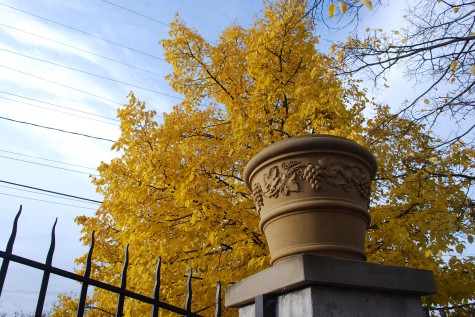 Tilia Cordata
Tilia Cordata
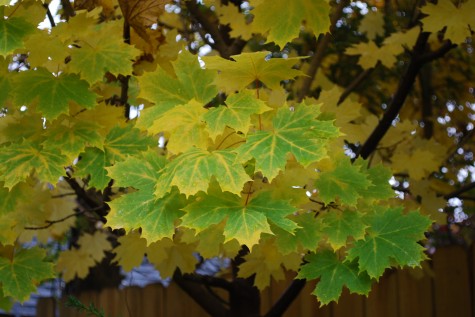 Acer Platanoides “Princeton Gold”
Acer Platanoides “Princeton Gold”
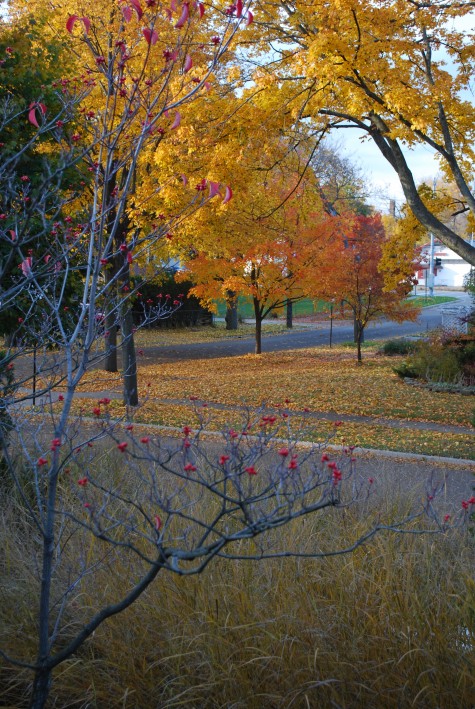 seeds Cornus Kousa
seeds Cornus Kousa
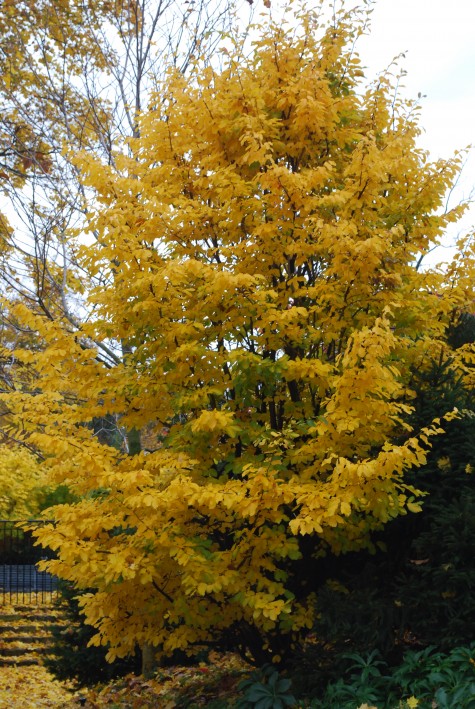 Parrotia Persica
Parrotia Persica
 Vitis
Vitis
 Betula Utilis var. Jacquemontii
Betula Utilis var. Jacquemontii
 Acer Platanoides “Princeton Gold”
Acer Platanoides “Princeton Gold”
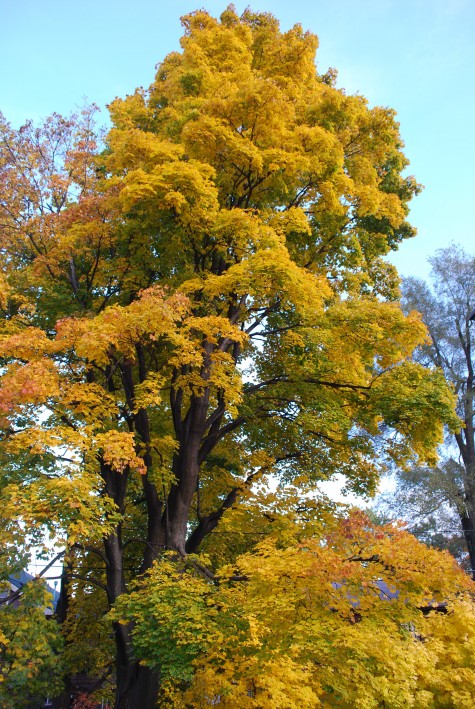 Acer Platanoides
Acer Platanoides
 Acer Platanoides
Acer Platanoides
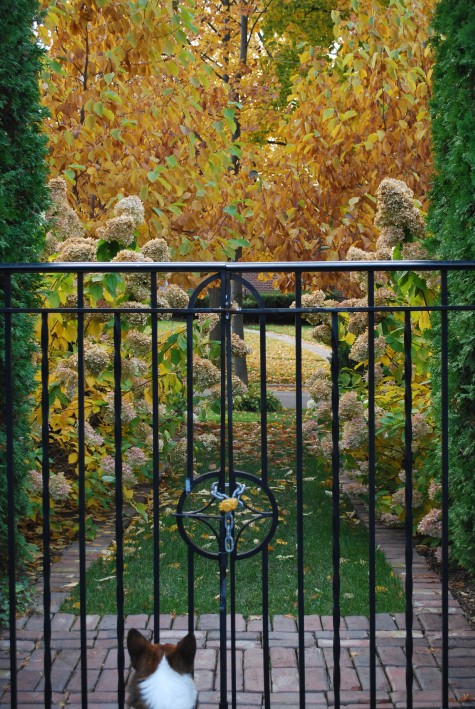 Magnolia x “Yellow Butterflies”
Magnolia x “Yellow Butterflies”
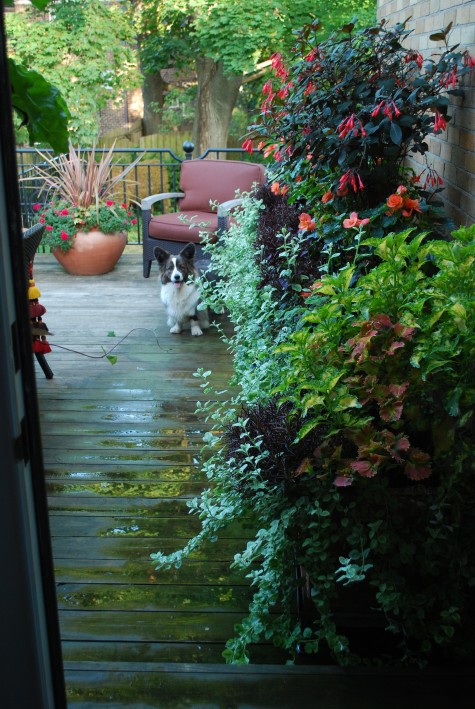 There are plenty of evenings during the course of the summer that I don’t have dinner outdoors-It could be too hot, or too buggy, or I might just be too tired to take everything outside only to have to bring it back in again. I also believe I have no end of summer days to choose from, but end they do. Yesterday it was benignly summer; today the weather is is cold and blustering towards fall. I know when I start coming to work in the dark, the close of summer can’t be far behind. As many nights as possible now, we all have dinner outdoors.
There are plenty of evenings during the course of the summer that I don’t have dinner outdoors-It could be too hot, or too buggy, or I might just be too tired to take everything outside only to have to bring it back in again. I also believe I have no end of summer days to choose from, but end they do. Yesterday it was benignly summer; today the weather is is cold and blustering towards fall. I know when I start coming to work in the dark, the close of summer can’t be far behind. As many nights as possible now, we all have dinner outdoors. Buck does all the cooking-lucky for me. My idea of dinner on my own consists of cans of black olives, chick peas, tinned tuna, slabs of good cheese and chips of some sort. I am also likely to eat this over the sink; who would make the effort to set a table, and then wash dishes over this? On my own, I don’t cook, I survive. I take care of what needs doing in support of the cooking, and I am happy with this arrangement. Buck decides to do a roast on the grill for our close of summer dinner.
Buck does all the cooking-lucky for me. My idea of dinner on my own consists of cans of black olives, chick peas, tinned tuna, slabs of good cheese and chips of some sort. I am also likely to eat this over the sink; who would make the effort to set a table, and then wash dishes over this? On my own, I don’t cook, I survive. I take care of what needs doing in support of the cooking, and I am happy with this arrangement. Buck decides to do a roast on the grill for our close of summer dinner. One doesn’t need to cook in order to appreciate great china. I could get out of hand easily; there are plenty of great china patterns out there. I get by with 2 sets; one is on permanent view on a shelf just sixteen inches below the ceiling in my kitchen. I take it down once a year to wash it; it’s out of the way, but always there for me to see. I built a painted Welsh cabinet for my other set. It took a long time to accumulate a service for eight, and even more time for the platters, breadbaskets and such. It was worth the wait; it is as much pleasure to look at as it is functional.
One doesn’t need to cook in order to appreciate great china. I could get out of hand easily; there are plenty of great china patterns out there. I get by with 2 sets; one is on permanent view on a shelf just sixteen inches below the ceiling in my kitchen. I take it down once a year to wash it; it’s out of the way, but always there for me to see. I built a painted Welsh cabinet for my other set. It took a long time to accumulate a service for eight, and even more time for the platters, breadbaskets and such. It was worth the wait; it is as much pleasure to look at as it is functional. 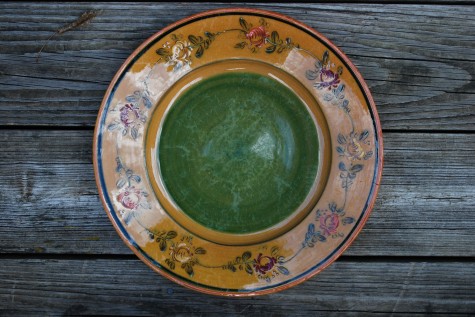 This French china is handmade by Veronique Pichon. None of her pieces have that perfect shape and repetition of design characteristic of machine made china. It is heavy, chunky and chip resistant-a good choice for china used outdoors. The green and ochre ground, with handpainted pink and rose flowers, looks good set in my garden.
This French china is handmade by Veronique Pichon. None of her pieces have that perfect shape and repetition of design characteristic of machine made china. It is heavy, chunky and chip resistant-a good choice for china used outdoors. The green and ochre ground, with handpainted pink and rose flowers, looks good set in my garden.  My stainless flatware has olivewood handles set in pewter ferrules. The color variation in the wood has everything to do with the dishwasher. The handles of the utensils I use every day have gone dark. As we only have dessert once in a great while, the olivewood is still pale colored. As much as I like limestone steps that are worn from all the walking, I like things that look like they have been used.
My stainless flatware has olivewood handles set in pewter ferrules. The color variation in the wood has everything to do with the dishwasher. The handles of the utensils I use every day have gone dark. As we only have dessert once in a great while, the olivewood is still pale colored. As much as I like limestone steps that are worn from all the walking, I like things that look like they have been used.  Of course we need flowers. The boltonia, Japanese anemone and asparagus from the garden look good in a McCoy ceramic vase from the forties. Cut flowers last such a long time outdoors-it must be the light. Cut flowers have a decidedly different feeling than flowers planted in the ground, as they are arranged.
Of course we need flowers. The boltonia, Japanese anemone and asparagus from the garden look good in a McCoy ceramic vase from the forties. Cut flowers last such a long time outdoors-it must be the light. Cut flowers have a decidedly different feeling than flowers planted in the ground, as they are arranged.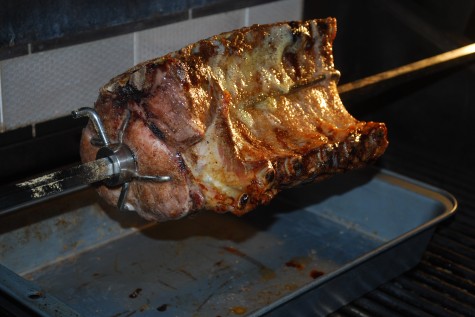 Buck loves to cook, and he says the rotisserie on the grill makes the work of it easy. If you are not a fan of cleaning the oven, cleaning a drip pan takes a lot less time and effort. The big design idea here-a terrace which is close to the kitchen makes it as easy to dine outside as it is to picnic-maybe easier. Good tools make quick work of the prep and cleanup. Sturdy china doesn’t mind being stacked for the trip back to the kitchen.
Buck loves to cook, and he says the rotisserie on the grill makes the work of it easy. If you are not a fan of cleaning the oven, cleaning a drip pan takes a lot less time and effort. The big design idea here-a terrace which is close to the kitchen makes it as easy to dine outside as it is to picnic-maybe easier. Good tools make quick work of the prep and cleanup. Sturdy china doesn’t mind being stacked for the trip back to the kitchen.  I like fresh food simply prepared-probably as I have been exposed to how good that can be. Food for me is not the main attraction-it is the place, the friends, the season and the weather and the food all rolled together that makes for a great time.
I like fresh food simply prepared-probably as I have been exposed to how good that can be. Food for me is not the main attraction-it is the place, the friends, the season and the weather and the food all rolled together that makes for a great time. 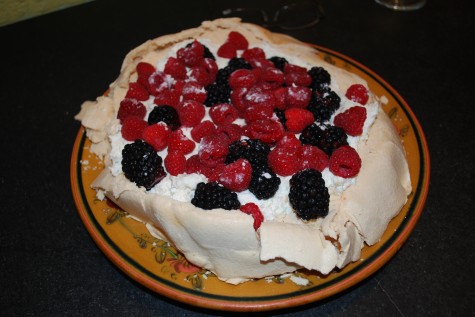 A pavlova for dessert-definitely out of the ordinary. A shell formed from a baked meringue is loaded with whipped cream and mascarpone cheese; this melt in your moth extravaganza is topped with a mix of the fruit of the season. Invented in New Zealand in honor of a visit by Anna Pavlova, it is my favorite summer dessert.
A pavlova for dessert-definitely out of the ordinary. A shell formed from a baked meringue is loaded with whipped cream and mascarpone cheese; this melt in your moth extravaganza is topped with a mix of the fruit of the season. Invented in New Zealand in honor of a visit by Anna Pavlova, it is my favorite summer dessert. 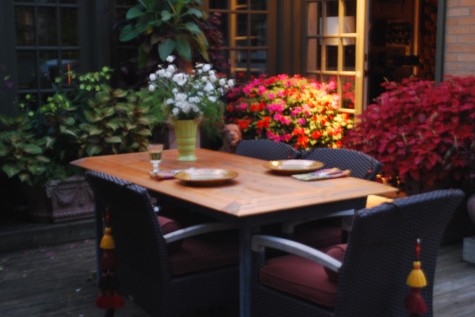

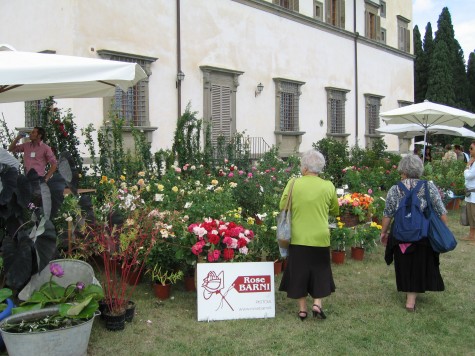
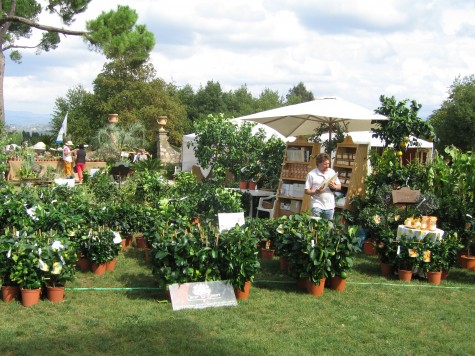 Fruit trees, fruiting shrubs and grape vines were represented in lots of varieties. We plan to offer fruiting trees, shrubs and grapevines at the store this coming spring, as Rob’s memory of this fair is a strong and good one. My favorite-the fruit cocktail trees, with 5 varieties of apples or pears, grafted onto a single rootstock. The idea of this appeals to my idea of gardening fun and festivity. I would have loved trees like this as a child, and I still do.
Fruit trees, fruiting shrubs and grape vines were represented in lots of varieties. We plan to offer fruiting trees, shrubs and grapevines at the store this coming spring, as Rob’s memory of this fair is a strong and good one. My favorite-the fruit cocktail trees, with 5 varieties of apples or pears, grafted onto a single rootstock. The idea of this appeals to my idea of gardening fun and festivity. I would have loved trees like this as a child, and I still do. 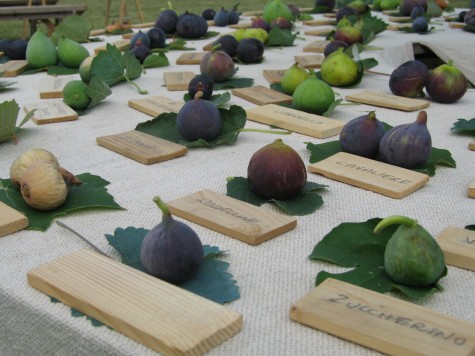 This display of different varieties of figs-more fun. How better to choose a fig tree than to have the fruit in front of you to hold, smell, and see? I do have a client of Italian descent growing fig trees; her love of gardening, growing food and cooking she inherited from her grandfather. One of his grapevines now grows in her garden. She is willing to bury her fig trees in compost for the winter-this tells you how much she wants them. How I envy the Italian climate such that they can grow figs, lemons and limes.
This display of different varieties of figs-more fun. How better to choose a fig tree than to have the fruit in front of you to hold, smell, and see? I do have a client of Italian descent growing fig trees; her love of gardening, growing food and cooking she inherited from her grandfather. One of his grapevines now grows in her garden. She is willing to bury her fig trees in compost for the winter-this tells you how much she wants them. How I envy the Italian climate such that they can grow figs, lemons and limes. 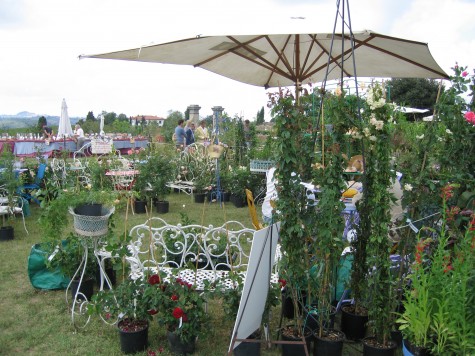 The little of this and some of that quality of this fair is engaging and charming. This is my favorite time of year for my own farmer’s market. The produce and fruit is as beautiful to look at, as it is to eat. The bunches of cut flowers, grass bouquet’s, the evidence of the summer harvest, speaks to much about why I garden. Making something grow is just plain satisfying.
The little of this and some of that quality of this fair is engaging and charming. This is my favorite time of year for my own farmer’s market. The produce and fruit is as beautiful to look at, as it is to eat. The bunches of cut flowers, grass bouquet’s, the evidence of the summer harvest, speaks to much about why I garden. Making something grow is just plain satisfying. The apples and pears have the spots, dings and scars that come with naturally grown fruit. Years ago I owned five acres that came with 20 fruit trees. I would pick the fruit warm from the sun and eat right then and there-around the spots if need be. This is a version of fine dining that I like.
The apples and pears have the spots, dings and scars that come with naturally grown fruit. Years ago I owned five acres that came with 20 fruit trees. I would pick the fruit warm from the sun and eat right then and there-around the spots if need be. This is a version of fine dining that I like. 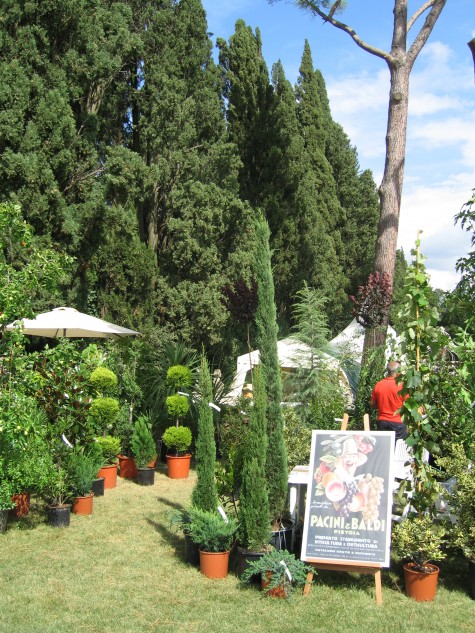
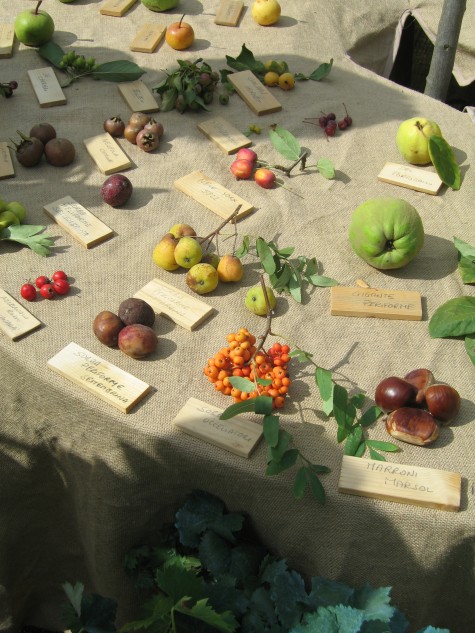 I am able to buy and eat food that cannot be grown where I live. I am glad I do not have to do without figs, lemons and mangoes. But Rob’s pictures make me wish I had been there.
I am able to buy and eat food that cannot be grown where I live. I am glad I do not have to do without figs, lemons and mangoes. But Rob’s pictures make me wish I had been there.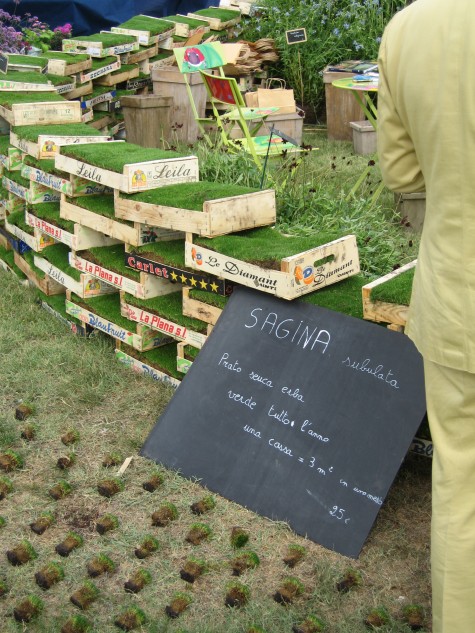 This is my favorite display-sagina subulata grown in fruit boxes. What a gorgeous look. This I could easily do. I might even like to just grow it in boxes. What would never occur to me to do-display the spacing layout on the ground. The sign says one box will get you three square meters of Sagina; if you don’t believe it, look here.
This is my favorite display-sagina subulata grown in fruit boxes. What a gorgeous look. This I could easily do. I might even like to just grow it in boxes. What would never occur to me to do-display the spacing layout on the ground. The sign says one box will get you three square meters of Sagina; if you don’t believe it, look here. 